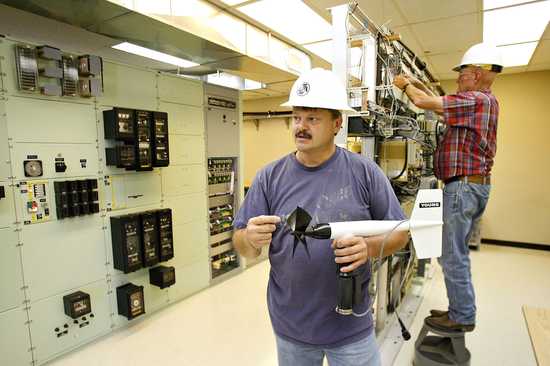forum
library
tutorial
contact

State Lands Commissioner Wants to
Branch Out to Wind, Biomass Energy
by Erik RobinsonThe Columbian, September 17, 2009
|
the film forum library tutorial contact |

|
State Lands Commissioner Wants to
by Erik Robinson |
 Lumber prices have fallen with the economic recession, but state lands commissioner Peter Goldmark said this week that there is still plenty of economic value in state forests -- and much of it is untapped.
Lumber prices have fallen with the economic recession, but state lands commissioner Peter Goldmark said this week that there is still plenty of economic value in state forests -- and much of it is untapped.
Biomass growing on 2.1 million acres of state forests could be burned to generate electricity or converted to a liquid fuel called methanol, he said. Further, he endorsed the careful expansion of the state's burgeoning wind energy business to the west side of the Cascades -- provided the massive towers won't imperil wildlife.
He's less concerned about spoiling views with blades spinning 400 feet off the ground.
"We're going to have to make compromises to achieve our goal of energy independence," Goldmark said during a meeting with The Columbian's editorial board on Tuesday.
State officials have delayed the granting of a lease proposed near Naselle, where public utility consortium Energy Northwest has proposed building Southwest Washington's first wind farm on Radar Ridge. The presence of a threatened seabird, the marbled murrelet, prompted the state to put the lease on hold.
"Radar Ridge is one of the worst places to site a wind project," he said.
Goldmark, a Democrat who defeated two-term incumbent commissioner Doug Sutherland last fall, said he actually camped out on the site to get a better sense of early-morning murrelet activity.
He spotted few birds. That might not be so surprising, considering that murrelets have dwindled nearly to the point of extinction.
"We all want to site these things," he said, referring to wind farms. "We have to do it in a manner that doesn't cause a conflict with endangered species."
To avoid wildlife conflicts in the future, Goldmark has directed the state Department of Natural Resources to work with state and federal wildlife management agencies. He anticipates the work will result in a map that steers developers toward areas with plenty of wind, few endangered critters and easy access to electrical transmission lines.
"Nobody wins in court," he said.
Growing potential
Wind is not the only renewable energy resource on state lands, he said.
Goldmark will sort through 30 proposals for two biomass pilot projects on state lands, one on the east and one on the west side of the Cascades. Goldmark, an Okanogan County rancher who earned a Ph.D. in molecular biology from the University of California at Berkeley, said he is especially intrigued by the possibility of turning logging slash into liquid fuel.
"I'm convinced that the technology exists," he said. "Whether it's commercially viable is another question."
Although converting wood into liquid methanol is nothing new, it's prohibitively expensive to transport logging slash, brush and dying trees out of remote forests to centralized plants. Instead, researchers at the University of Washington are working with a private-sector partner to develop truck-mounted mobile technology.
If it works, Goldmark said, the process could produce gallon of diesel fuel for every 25 pounds of dry pine or fir.
The Department of Natural Resources could play a major role in the development of mobile technology, he said. Because the state has such an ample supply of overstocked timber stands -- especially on the east side of the Cascades, where insect infestations have raised the fire hazard -- Goldmark said the state has no shortage of raw material. It's preferable to convert it into fuel before it's consumed in wildfires, he said.
"We can no longer stand by and watch our forests burn," he said.
learn more on topics covered in the film
see the video
read the script
learn the songs
discussion forum
